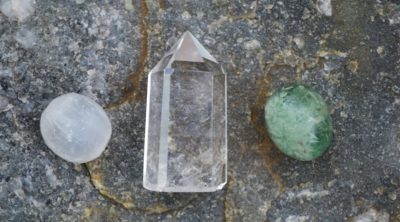
Apatite includes a group of phosphate minerals. Apatite uses range from manufacture of fertilizers to being used as a gemstone for decorative and healing purposes.
Apatite is the name given to a group of phosphate minerals which include Hydroxylapatite, Chlorapatite, Bromapatite and Fluorapatite. Hydroxylapatite is a major building material of tooth enamel and bone mineral. However, Fluorapatite is better than Hydroxylapatite at resisting acidic corrosion, hence, toothpastes typically contain either Sodium Fluoride or Sodium Monofluorophosphate. Also, fluoridated water enables fluoride ions to be exchanged for apatite hydroxyl group, in teeth. Apatite, though found all over the world, is extensively found as mineral deposits in Russia and Kola, Peninsula. It is found in its blue and purple crystal forms in Ehrenfriedersdorf, Germany. The colorless variation occurs in Austria and Portugal. Gigantic apatite crystal deposits have been mined for industrial purposes in Morocco, Israel, Tunisia, Egypt and Nauru. Apatite uses span across diverse fields and uses of apatite determine the different forms of it that we know – as a mineral, as a gemstone or as apatite crystals.
Uses of Apatite as Mineral
As a mineral, apatite is chiefly used as a phosphorus source for the manufacture of fertilizers. Apatite mineral uses also extend to fluoridating water, and a protective coat of apatite on metals prevent it from rusting. One of the primary physical properties of apatite is that, in its mineral form, apatite is very stable and does not easily dissolve in a natural environment. In their mineral forms, all apatite have the ability to absorb radioactive and metallic contaminants, and keep them locked. This is one of the most significant apatite properties which makes it an excellent choice for removing radioactive contaminants, like Strontium-90, from groundwater. Apatite can also be used as an ore mineral for rare earth metals such as Scandium, Yttrium and the fifteen Lanthanides – Cerium, Praseodymium, Neodymium, Promethium, Samarium, Europium, Gadolinium, Terbium, Dysprosium, Holmium, Erbium, Thulium, Ytterbium and Lutetium. Since apatite is non-radioactive, it is preferred over other traditional rare earth ores to prevent environmental hazards during mine tilling. As a matter of fact, apatite uses are widespread in the Hoidas Lake Rare Earth Elements Mining Project.
Uses of Apatite as Gemstone
Apatite scores 5 on the Mohs scale of hardness, where Talc scores 1 and Diamond scores 10. Hence, while it is not as soft as Talc, it is definitely not as strong as Diamond. Due to this reason, apatite, as gemstones, are not very popular as jewelry items. However, discovery of the neon blue-green variety from Madagascar has given it some recognition in the gemstone jewelry circuit. Though not so popular as a jewel, apatite as a gemstone, is highly regarded for its alternative healing properties. Apatite healing has prevailed since ages and is known to be a great spiritual cleanser. This gemstone, especially variants having hues of blue, represents the Wind element which makes it a powerful influencer of communication, compassion and insight. Air is the element that rules apatite, meaning it is a stimulator of psychic gifts such as clairvoyance, clairaudience and clairsentience. Apatite is a great crystal for Gemini natives and is excellent at negating any physical, mental, emotional and spiritual blocks. It has been associated with appetite control and weight loss over centuries, and is believed to ward off viruses.
Importance of Apatite in Crystal Healing
Uses of blue apatite include healing physical disturbances such as toothache, headaches, stimulating eyesight, cure vertigo and strengthen the immune system. This gemstone also helps in tapping into the dreams and the subconscious mind to find answers to deep-rooted problems of the daily life. It clears up emotional “clutter” and gives one a higher perspective on situations and viewpoints. Apatite crystals that are yellowish-green in color are believed to be able to dispel negative feelings and energies, and are helpful in making an individual receptive to positive vibrations.
Significance of Apatite in Space Research
Traces of the mineral form of apatite have been found in the lunar rocks that were brought back by astronauts returning from the Apollo Program. A recent analysis of these rocks have also shown the presence of water, in its hydroxyl form, in the apatite content of these rocks. These findings have contributed to knowledge about the quantity and proportion of water present on the surface of the moon.
This calcium phosphate mineral, though little known to the layman, offers something or the other to all walks of life, yet we hardly realize its presence! As a mineral, it nurtures the ecology and as a gemstone it introduces beauty and clarity in our lives. Uses and benefits of apatite are so diverse in nature that this mineral has a niche following in both industrial as well as personal spheres of existence.






